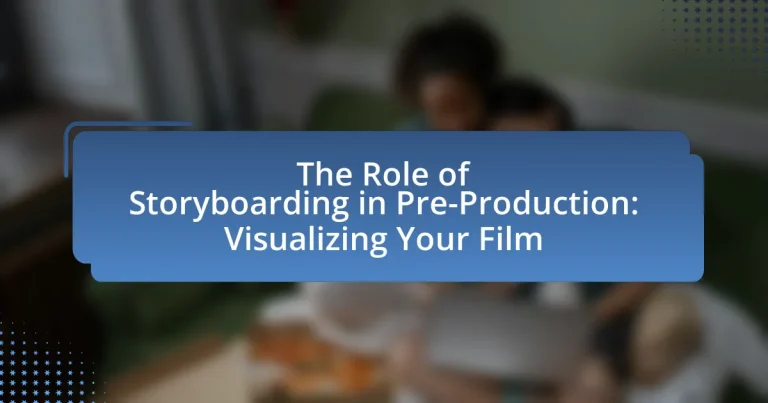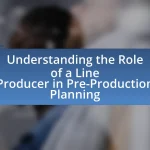The article focuses on the critical role of storyboarding in the pre-production phase of filmmaking, emphasizing its function as a visual blueprint that outlines scenes, actions, and transitions. It details how storyboarding aids in planning narrative structure, enhances communication among the production team, and identifies potential issues before filming begins. Key elements of storyboards, techniques used, and the impact on shot planning, resource management, and the editing process are discussed. Additionally, the article highlights best practices for effective storyboarding and the benefits of collaboration in creating a cohesive visual narrative.
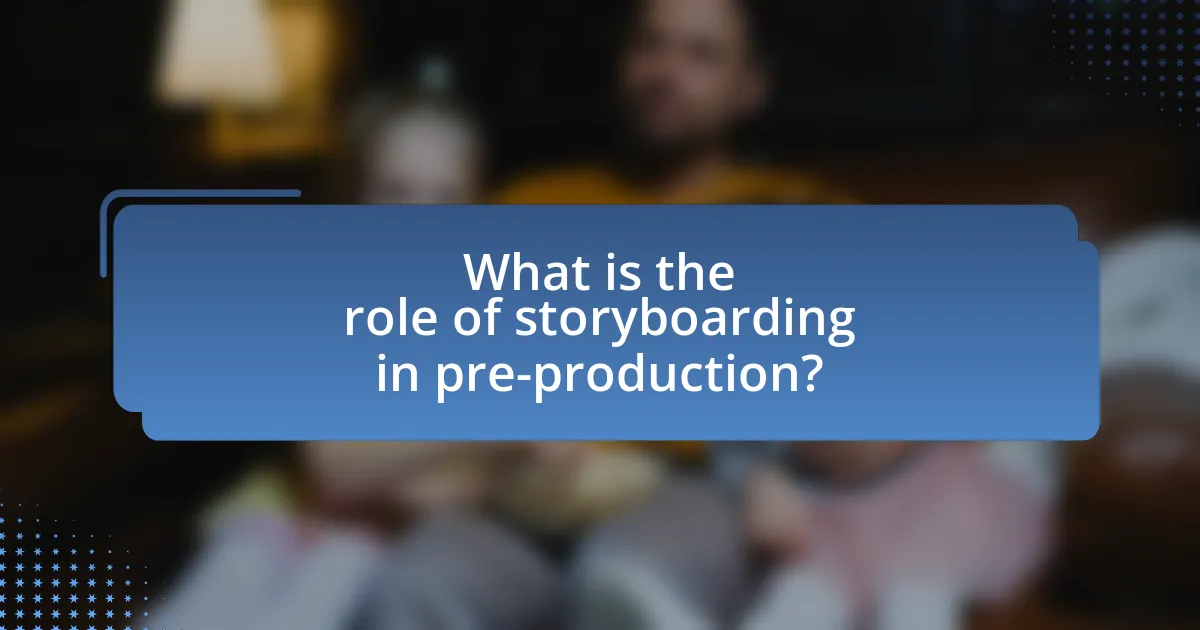
What is the role of storyboarding in pre-production?
Storyboarding in pre-production serves as a visual blueprint for a film, outlining scenes, actions, and transitions. This process allows filmmakers to plan the narrative structure and visualize the sequence of events, ensuring clarity in storytelling. By creating a series of illustrations or images, storyboarding helps identify potential issues in pacing, composition, and continuity before filming begins. Studies show that effective storyboarding can enhance communication among the production team, streamline the shooting process, and ultimately lead to a more cohesive final product.
How does storyboarding contribute to the filmmaking process?
Storyboarding significantly contributes to the filmmaking process by providing a visual representation of the narrative, allowing filmmakers to plan scenes effectively. This visual tool helps in organizing the sequence of events, determining camera angles, and establishing the pacing of the film. By illustrating key moments, storyboards facilitate communication among the director, cinematographer, and production team, ensuring everyone shares a unified vision. Furthermore, studies show that films with detailed storyboards often experience fewer production issues, as they allow for better resource allocation and time management during shooting.
What are the key elements of a storyboard?
The key elements of a storyboard include panels, visuals, annotations, and sequencing. Panels represent individual scenes or shots, providing a visual framework for the narrative. Visuals depict characters, settings, and actions, allowing for a clear representation of the story’s flow. Annotations offer additional context, such as dialogue, camera angles, and movement directions, enhancing understanding of the intended execution. Sequencing arranges the panels in chronological order, ensuring a coherent progression of the storyline. These elements collectively facilitate effective communication of the film’s vision during pre-production.
How does a storyboard help in visualizing scenes?
A storyboard helps in visualizing scenes by providing a sequential visual representation of each shot in a film or animation. This visual format allows filmmakers to plan the composition, timing, and transitions of scenes effectively. By illustrating key moments, storyboards facilitate communication among the production team, ensuring that everyone shares a clear understanding of the narrative flow and visual style. Studies have shown that using storyboards can enhance creativity and efficiency in the filmmaking process, as they allow for easier identification of potential issues before filming begins.
Why is storyboarding essential for filmmakers?
Storyboarding is essential for filmmakers because it provides a visual representation of the narrative, allowing for better planning and organization of scenes. This visual tool helps filmmakers to map out the sequence of events, determine shot composition, and identify potential challenges before filming begins. Research indicates that storyboarding can enhance communication among the production team, ensuring that everyone shares a clear vision of the project. According to a study published in the Journal of Film and Video, effective storyboarding can lead to a 30% reduction in production time by minimizing misunderstandings and streamlining the shooting process.
What advantages does storyboarding provide during pre-production?
Storyboarding provides several advantages during pre-production, primarily by visualizing the narrative and planning the film’s structure. This visual representation allows filmmakers to identify potential issues in pacing, continuity, and scene transitions before actual filming begins. Additionally, storyboards facilitate clearer communication among the production team, ensuring that everyone shares a unified vision of the project. Research indicates that projects utilizing storyboards can reduce production time by up to 30%, as they streamline the decision-making process and minimize costly revisions during filming.
How does storyboarding facilitate communication among the crew?
Storyboarding facilitates communication among the crew by providing a visual representation of the film’s narrative and structure. This visual tool allows directors, cinematographers, and other crew members to understand the sequence of scenes, camera angles, and character movements, ensuring everyone is aligned on the creative vision. Research indicates that visual aids, like storyboards, enhance comprehension and retention of information, which is crucial in a collaborative environment where clarity is essential for effective teamwork. By using storyboards, crew members can discuss specific scenes more efficiently, reducing misunderstandings and streamlining the production process.
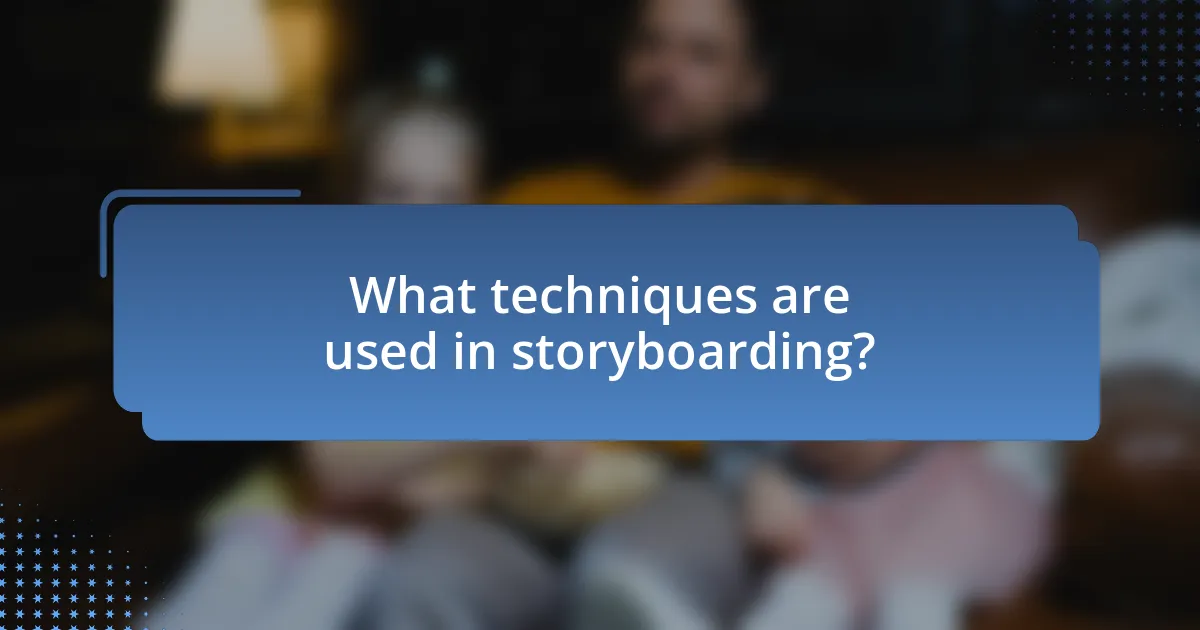
What techniques are used in storyboarding?
Techniques used in storyboarding include sketching, digital tools, and animatics. Sketching allows creators to visualize scenes quickly, capturing key moments and actions. Digital tools, such as software like Storyboard Pro or Photoshop, enable more precise and editable storyboards, facilitating collaboration among team members. Animatics, which are animated versions of storyboards, help in timing and pacing by providing a clearer sense of how scenes will flow together. These techniques enhance communication and planning in the pre-production phase of filmmaking, ensuring that the vision is effectively conveyed to the entire production team.
How can different styles of storyboarding impact a film’s vision?
Different styles of storyboarding can significantly impact a film’s vision by influencing the clarity of the narrative and the emotional tone conveyed. For instance, a detailed, shot-by-shot storyboard allows filmmakers to visualize complex scenes and transitions, ensuring that the intended mood and pacing are effectively communicated. In contrast, a more abstract or loose storyboard may prioritize thematic elements over specific visuals, which can lead to a more interpretive approach to storytelling. Research indicates that films with well-structured storyboards tend to have a clearer narrative flow, as seen in successful productions like “The Lion King,” where meticulous storyboarding facilitated seamless storytelling and emotional engagement. Thus, the choice of storyboard style directly shapes how a film’s vision is realized on screen.
What are the common types of storyboards used in the industry?
The common types of storyboards used in the industry include traditional storyboards, animatics, digital storyboards, and thumbnail storyboards. Traditional storyboards consist of hand-drawn images arranged in sequence to visualize scenes, while animatics are animated versions of storyboards that incorporate timing and sound to give a clearer sense of the final product. Digital storyboards utilize software for more flexibility and ease of editing, and thumbnail storyboards are small, quick sketches that capture key moments without detailed artwork. These types are widely recognized in film and animation production for their effectiveness in planning visual narratives.
How do digital storyboarding tools compare to traditional methods?
Digital storyboarding tools offer greater efficiency and flexibility compared to traditional methods. While traditional storyboarding typically involves hand-drawn sketches on paper, digital tools allow for easy editing, rearranging, and sharing of storyboards, which can significantly streamline the pre-production process. For instance, software like Storyboard Pro or Canva enables filmmakers to quickly modify scenes, add annotations, and collaborate in real-time, enhancing communication among team members. Additionally, digital tools often include features such as templates, drag-and-drop functionality, and integration with other production software, which can save time and reduce the likelihood of errors. In contrast, traditional methods can be more time-consuming and less adaptable to changes, making digital tools a preferred choice in modern filmmaking.
What are the best practices for effective storyboarding?
The best practices for effective storyboarding include clearly defining the narrative structure, utilizing visual consistency, and incorporating detailed annotations. Clearly defining the narrative structure ensures that the story flows logically, allowing viewers to understand the progression of events. Visual consistency, achieved through maintaining a uniform style and color palette, helps in conveying the mood and tone of the film effectively. Detailed annotations provide context for each frame, including camera angles, movements, and dialogue, which aids in the production process. Research indicates that well-structured storyboards can enhance communication among the production team, leading to a more efficient filming process and a cohesive final product.
How can filmmakers ensure clarity in their storyboards?
Filmmakers can ensure clarity in their storyboards by using clear visuals, concise annotations, and consistent formatting. Clear visuals help convey the intended action and composition, while concise annotations provide essential context without overwhelming details. Consistent formatting, such as uniform character sizes and scene layouts, aids in quick comprehension. Research indicates that effective storyboarding can improve communication among team members, leading to a smoother production process. For instance, a study by the University of Southern California found that well-structured storyboards significantly reduce misunderstandings during filming, enhancing overall efficiency.
What common mistakes should be avoided in storyboarding?
Common mistakes to avoid in storyboarding include neglecting to plan the sequence of shots, which can lead to disjointed storytelling. Additionally, failing to consider the pacing and timing of scenes can disrupt the flow of the narrative. Not incorporating feedback from collaborators can result in missed opportunities for improvement. Overcomplicating scenes with excessive detail can clutter the storyboard and obscure the main ideas. Lastly, ignoring the target audience’s perspective may lead to a disconnect between the story and its viewers. These mistakes can hinder the effectiveness of the storyboard in visualizing the film.
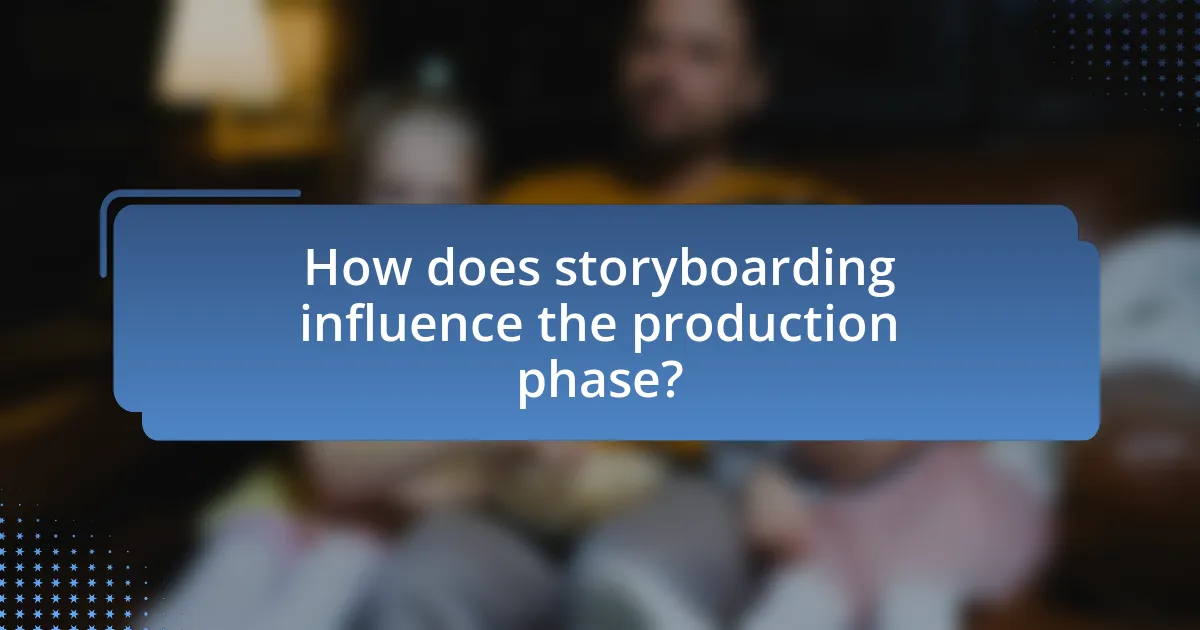
How does storyboarding influence the production phase?
Storyboarding significantly influences the production phase by providing a visual blueprint that guides the filming process. This visual representation allows directors and cinematographers to plan shots, determine camera angles, and establish the pacing of scenes before actual filming begins. By having a clear storyboard, production teams can streamline their workflow, reduce the likelihood of costly mistakes, and ensure that the final product aligns with the original vision. Studies have shown that projects utilizing storyboards experience improved communication among team members and enhanced efficiency, ultimately leading to a more cohesive and organized production process.
What role does storyboarding play in shot planning?
Storyboarding plays a crucial role in shot planning by providing a visual representation of each scene, allowing filmmakers to organize and sequence shots effectively. This visual tool helps in determining camera angles, framing, and transitions, ensuring that the narrative flows cohesively. By illustrating the action and composition, storyboards facilitate communication among the production team, reducing misunderstandings and enhancing collaboration. Furthermore, studies show that projects utilizing storyboards often experience a 30% reduction in production time, as they streamline the decision-making process and minimize costly revisions during filming.
How can storyboards assist in managing time and resources during filming?
Storyboards assist in managing time and resources during filming by providing a visual representation of each scene, which helps streamline the shooting process. By outlining the sequence of shots, storyboards allow filmmakers to plan camera angles, lighting, and actor movements in advance, reducing the likelihood of costly reshoots or extended filming days. For instance, a study by the University of Southern California found that projects utilizing storyboards experienced a 30% reduction in production time compared to those that did not. This efficiency not only saves time but also optimizes resource allocation, ensuring that crew members and equipment are utilized effectively throughout the filming process.
What impact does storyboarding have on the editing process?
Storyboarding significantly streamlines the editing process by providing a visual roadmap of the film’s narrative structure. This visual representation allows editors to understand the intended flow and pacing of scenes, facilitating more efficient cuts and transitions. Furthermore, storyboards help identify potential continuity issues before filming begins, reducing the need for extensive re-editing later. Studies have shown that projects utilizing storyboards can complete the editing phase up to 30% faster, as editors can work with a clear reference of the director’s vision.
How can filmmakers maximize the benefits of storyboarding?
Filmmakers can maximize the benefits of storyboarding by creating detailed and organized visual representations of each scene, which enhances communication among the production team. This practice allows filmmakers to visualize the narrative flow, plan camera angles, and identify potential issues before filming begins. Research indicates that storyboarding can reduce production costs by up to 30% by minimizing the need for extensive reshoots and facilitating clearer direction for actors and crew. Additionally, a well-structured storyboard serves as a reference point throughout the filming process, ensuring that the creative vision is consistently executed.
What tips can enhance the effectiveness of storyboarding in pre-production?
To enhance the effectiveness of storyboarding in pre-production, filmmakers should focus on clarity, detail, and collaboration. Clarity in each storyboard frame ensures that the visual narrative is easily understood by the entire production team, reducing miscommunication. Including detailed notes about camera angles, movements, and character emotions within each frame provides context that aids in the visualization process. Collaboration with key team members, such as the director, cinematographer, and production designer, during the storyboarding phase fosters a shared vision and allows for valuable input that can refine the storyboard. Research indicates that effective storyboarding can lead to a 30% reduction in production time, as it streamlines the planning process and minimizes the need for extensive revisions during filming.
How can collaboration improve the storyboarding process?
Collaboration can significantly enhance the storyboarding process by integrating diverse perspectives and expertise, leading to more comprehensive visual narratives. When multiple team members, such as writers, directors, and artists, contribute their insights, the storyboards become richer and more aligned with the overall vision of the film. Research indicates that collaborative environments foster creativity and innovation; for instance, a study published in the Journal of Creative Behavior found that teams working together produced higher-quality creative outputs compared to individuals working in isolation. This collective input not only improves the visual storytelling but also ensures that all aspects of the narrative are considered, ultimately resulting in a more cohesive and engaging film.
